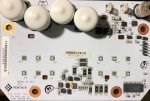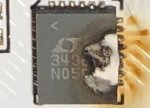I am not really a fan of Pool LED lights and it's not because they are a bad idea, a lot of work goes into the LED enclosure packaging, thermal design.
The protocol for setting colors etc is done by turning the lights on and off for specific times, which is annoyingly slow, but cheap to manufacture.
The lamp brightness is still low compared to a car headlamp, yet has much better cooling opportunity!
Yes, LED lights are cheaper to make than the older motorized halogen lamps, but (I guess here is my point!) they are much harder to repair!
Digging deeper . . . .
Take this little gem from a 2 year old Pantair LED PCB:

The component labelled "U1" is a chip called a 3 channel LED driver, it looks pretty sad!

It is a $9 part from a company called Analog Devices, from the data sheet it can dim each channel providing up to 0.75A from any input voltage from 3V to 30V.
Since, I trust the manufacturer and this chip generates a constant current, my guess is it has seen an output overvoltage condition when switching the inductors. This is a common faw in these designs.
So, all the LED's are still good, what to do next?
Well, I could buy a new chip, but the device has an exposed pad underneath and the PCB is built on a copper substrate so, requires special reflow soldering tooling.
A new PCB is in the $300 to $400 range (maybe higher).
Ok, so I may choose to build my own . . . what is the market like for alternative Pantair PCB's?
The protocol for setting colors etc is done by turning the lights on and off for specific times, which is annoyingly slow, but cheap to manufacture.
The lamp brightness is still low compared to a car headlamp, yet has much better cooling opportunity!
Yes, LED lights are cheaper to make than the older motorized halogen lamps, but (I guess here is my point!) they are much harder to repair!
Digging deeper . . . .
Take this little gem from a 2 year old Pantair LED PCB:

The component labelled "U1" is a chip called a 3 channel LED driver, it looks pretty sad!

It is a $9 part from a company called Analog Devices, from the data sheet it can dim each channel providing up to 0.75A from any input voltage from 3V to 30V.
Since, I trust the manufacturer and this chip generates a constant current, my guess is it has seen an output overvoltage condition when switching the inductors. This is a common faw in these designs.
So, all the LED's are still good, what to do next?
Well, I could buy a new chip, but the device has an exposed pad underneath and the PCB is built on a copper substrate so, requires special reflow soldering tooling.
A new PCB is in the $300 to $400 range (maybe higher).
Ok, so I may choose to build my own . . . what is the market like for alternative Pantair PCB's?

